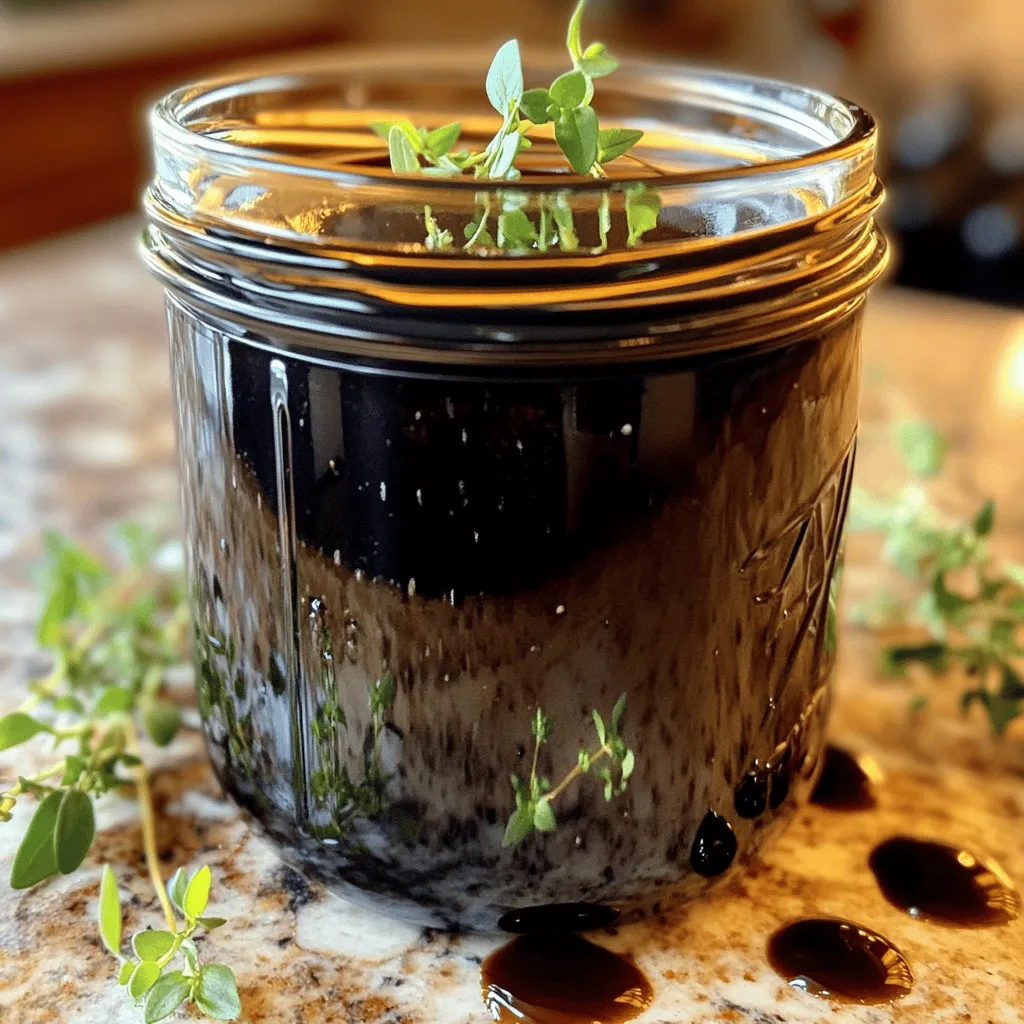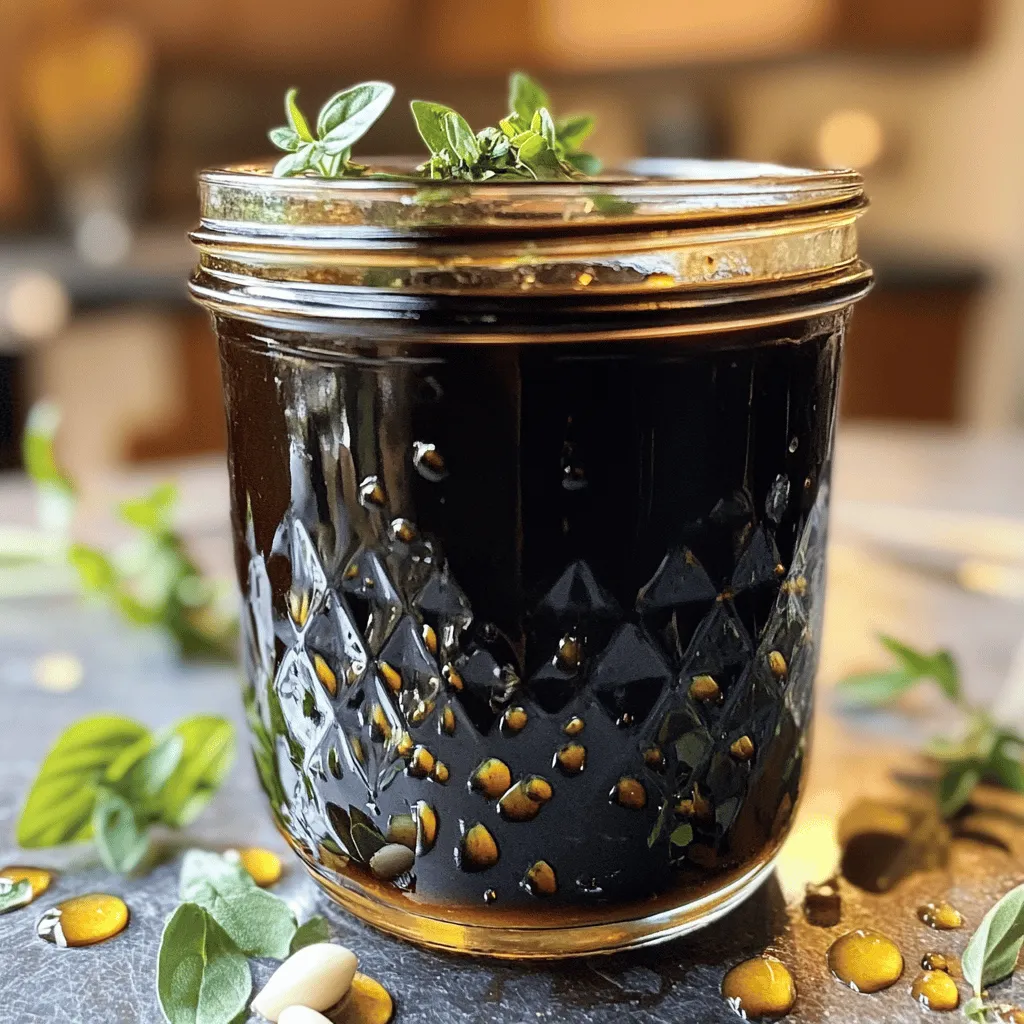Looking for a tasty way to enjoy balsamic glaze without the sugar? You’re in the right place! My Homemade Balsamic Glaze Without Sugar Delight transforms simple ingredients into a rich, flavorful topping. With just balsamic vinegar and a hint of sweetness from maple syrup, this glaze enhances any dish—salads, meats, and veggies included. Let’s dive into making a delicious, healthy glaze that fits your lifestyle!
Ingredients
List of Ingredients
– 2 cups balsamic vinegar
– 1 tablespoon pure maple syrup
– 1 teaspoon garlic powder
– 1 teaspoon onion powder
– 1 teaspoon dried oregano
– 1/2 teaspoon salt
– 1/4 teaspoon freshly cracked black pepper
Alternative Sweeteners
You can use other sugar-free sweeteners if you want. Options like stevia or monk fruit work well. They add sweetness without the sugar. If you choose these, start with a small amount. Taste as you go. You can always add more if needed.
Benefits of a Sugar-Free Balsamic Glaze
Using a sugar-free balsamic glaze has many health perks. It cuts down on sugar intake, which is great for your body. Less sugar can mean more energy and better health. Plus, this glaze still packs a punch in flavor. It gives you the tangy and sweet kick that you love. It’s a great swap for the traditional glaze without losing taste.
Step-by-Step Instructions
Preparation Steps
– Setting up your saucepan: Start by grabbing a medium-sized saucepan. Pour 2 cups of balsamic vinegar into it. Use a pan that is wide enough for good evaporation. This helps the glaze thicken nicely.
– Combining ingredients: Now, let’s add some flavor. Mix in 1 tablespoon of pure maple syrup. This gives your glaze a hint of sweetness. Next, add 1 teaspoon of garlic powder, 1 teaspoon of onion powder, 1 teaspoon of dried oregano, 1/2 teaspoon of salt, and 1/4 teaspoon of freshly cracked black pepper. Stir well to blend all the ingredients together.
Cooking Process
– Detailed simmering instructions: Place the saucepan on the stove and set the heat to medium. Gently bring the mixture to a simmer. This step lets all the flavors mix beautifully.
– Tips for achieving the right consistency: Once it simmers, lower the heat to low. Let it simmer for about 20-25 minutes. Stir it occasionally. You’re looking for a syrupy thickness. If it’s too thin, keep simmering until you reach the right consistency.
Cooling and Storing
– How to properly cool the glaze: After thickening, take the saucepan off the heat. Let the glaze cool for a few minutes. Cooling helps the flavors settle and improve.
– Best storage practices for longevity: Transfer the glaze into a clean jar or airtight container. Allow the glaze to cool completely at room temperature before sealing it. This homemade balsamic glaze lasts up to 2 weeks in the fridge. Store it carefully to keep it fresh and tasty.
For the full recipe, check out the details above. Enjoy drizzling your homemade glaze on your favorite dishes!
Tips & Tricks
Perfecting Texture and Flavor
To achieve the right thickness for your balsamic glaze, simmer it longer. The longer you cook it, the thicker it gets. If the glaze is too thick, add a splash of water. This helps reach the perfect syrup-like texture without changing the taste.
Balancing sweetness and acidity is key. The maple syrup adds a mild sweetness. Taste as you go to ensure it’s not too sweet. Adjust the maple syrup to fit your taste. This balance makes the glaze shine in your dishes.
Presentation Tips
You can use balsamic glaze in many creative ways. Drizzle it over roasted vegetables for a pop of flavor. It also works well on grilled meats and fresh salads.
For a fun idea, use a squeeze bottle. This makes it easy to create designs on your plates. You can also serve it in a small bowl for dipping. It adds an elegant touch to any meal.
Cooking Equipment and Tools
Choose a medium saucepan for best results. A heavy-bottomed pan helps the glaze cook evenly. Avoid using non-stick pans, as they can alter the glaze’s taste.
For storage, use a glass jar or airtight container. This keeps the glaze fresh in the fridge. Make sure the container is clean before adding the glaze. This helps it last longer while maintaining its great flavor.

Variations
Different Flavor Profiles
You can change the taste of your balsamic glaze easily. Simply add herbs like rosemary or thyme. These herbs give a fresh and aromatic touch. If you want a zesty kick, try adding lemon or orange zest. This will brighten the flavor. A little zest can take your glaze to a new level.
Dietary Variations
This glaze is naturally vegan, making it perfect for plant-based dishes. It has no animal products, so everyone can enjoy it. Plus, it is gluten-free. Use this glaze without worry if you follow a gluten-free diet. It fits many dietary needs and keeps meals tasty.
How to Use with Other Ingredients
You can use this balsamic glaze in many ways. It works great in marinades for meats or veggies. Just mix it with oil and your favorite spices for a simple marinade. It adds depth and flavor. You can also make salad dressings with it. Combine it with olive oil and herbs for a delicious dressing. Drizzle it over your salads for a balsamic twist. You can find lots of ways to enjoy this glaze in your meals.
For the full recipe, check out the Zesty Homemade Balsamic Glaze section.
Storage Info
How Long Can it Last?
Homemade balsamic glaze can last up to two weeks in the fridge. To keep it fresh, store it in an airtight container. Watch for signs of spoilage like an off smell, changes in color, or mold. If you see any of these, it’s best to toss it out.
Best Practices for Refrigeration
Store your balsamic glaze in the fridge at a temperature below 40°F (4°C). Use a clean glass jar or a plastic container with a tight lid. This helps keep the glaze fresh and prevents it from absorbing other smells in the fridge.
Reheating Instructions
To reheat your glaze, warm it gently on the stove over low heat. Stir it often to keep its smooth texture. Avoid boiling, as this can change the flavor. When reheating, always check the temperature. Make sure it reaches at least 165°F (74°C) for safety.
FAQs
Can I use other vinegars to make this glaze?
Yes, you can use other vinegars. Red wine vinegar gives a fruity note. Apple cider vinegar adds a slight sweetness. White vinegar is sharper and less complex. Each vinegar changes the taste. Experiment to find your favorite.
Is it necessary to use maple syrup?
No, it’s not necessary. You can use honey or agave nectar. These add a different sweetness. If you like no added sweetener, just skip it. The glaze will still taste great, but less sweet.
How can I adjust the thickness of the glaze?
To change the thickness, adjust the cooking time. If you want a thicker glaze, simmer longer. Stir the glaze often to avoid burning. For a thinner glaze, reduce cooking time. This gives you control over the final result.
What dishes pair well with homemade balsamic glaze?
This glaze works great on many dishes. Drizzle it over salads for added flavor. It complements grilled meats, like chicken or steak. Roasted vegetables also shine with this glaze. Try it on pizza or as a dipping sauce! For more ideas, check the Full Recipe.
Making your own sugar-free balsamic glaze is simple and rewarding. We explored key ingredients and alternative sweeteners to customize flavor. Reducing sugar not only boosts health but enhances taste. The step-by-step instructions help you create a perfect glaze, while tips and variations let you get creative in the kitchen. Remember to store properly for lasting quality. With a few adjustments, you can enjoy this versatile glaze on various dishes. Now, it’s time to get cooking and refine your own tasty recipes!

